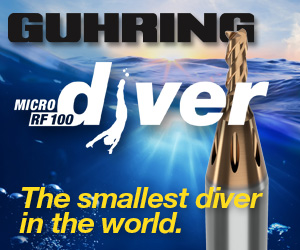Contact Details
Precision Cutting Tools says its new Hi-Depth Long Drills (40xD-50xD) have proven to be a huge success in deep-hole drilling applications. Many users have been able to reduce their cycle times by 85 percent, while simultaneously increasing their productivity by up to five times.
The Hi-Depth Long Drills are available in two styles, AXC Series (Triple Margin) for aluminum and gray cast iron and SXC series (double margin) for titanium, Inconel and stainless steels. Both drills possess self-centering capabilities and internal coolant holes, for peck-free machining. In addition, the drills feature parabolic flutes, permitting higher speeds/feeds with efficient chip evacuation.
Diameter ranges available: 40xD (3.0-8.0mm) and 50xD (3.0-6.0mm). Other dimensions are available upon request.
Benefits:
• No pecking cycles
• Efficient chip removal
• Reduced machining time
• Longer tool life
Features:
• Parabolic flutes
• Coolant-hole geometry
• Self-centering capabilities
• EdgeCut technology
• Premium PVD coatings
Related Glossary Terms
- coolant
coolant
Fluid that reduces temperature buildup at the tool/workpiece interface during machining. Normally takes the form of a liquid such as soluble or chemical mixtures (semisynthetic, synthetic) but can be pressurized air or other gas. Because of water’s ability to absorb great quantities of heat, it is widely used as a coolant and vehicle for various cutting compounds, with the water-to-compound ratio varying with the machining task. See cutting fluid; semisynthetic cutting fluid; soluble-oil cutting fluid; synthetic cutting fluid.
- flutes
flutes
Grooves and spaces in the body of a tool that permit chip removal from, and cutting-fluid application to, the point of cut.
- physical vapor deposition ( PVD)
physical vapor deposition ( PVD)
Tool-coating process performed at low temperature (500° C), compared to chemical vapor deposition (1,000° C). Employs electric field to generate necessary heat for depositing coating on a tool’s surface. See CVD, chemical vapor deposition.
- stainless steels
stainless steels
Stainless steels possess high strength, heat resistance, excellent workability and erosion resistance. Four general classes have been developed to cover a range of mechanical and physical properties for particular applications. The four classes are: the austenitic types of the chromium-nickel-manganese 200 series and the chromium-nickel 300 series; the martensitic types of the chromium, hardenable 400 series; the chromium, nonhardenable 400-series ferritic types; and the precipitation-hardening type of chromium-nickel alloys with additional elements that are hardenable by solution treating and aging.






